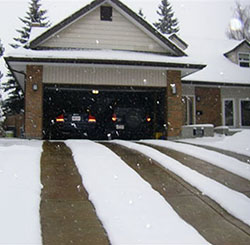The Costs of Not Having a Radiant Heated Driveway
Protect Yourself From the Snowy Dangers of Winter
As radiant heated driveways increase in popularity you may have wondered what it is that makes them so great. Sure they eliminate the need to shovel or plow, but are they really that great? And are you missing out by not installing one?
Besides being affordably luxurious, heated driveway systems are a lot more than just a quick and easy way to melt snow. They are your surefire way to keep you, your family, or your customers safe this winter. The operate cleanly on renewable energy, are maintenance free and fully automated.
 While installing a heated driveway system requires an initial investment,
the costs of not installing one are proof that your investment is well
worth it.
While installing a heated driveway system requires an initial investment,
the costs of not installing one are proof that your investment is well
worth it.
Physical Injuries
Every winter, thousands of Americans are injured from snow-related injuries. Slipping and falling on an icy driveway is a one-way ticket to misery and pricey hospital bills—the last thing you need in the already blustery winter season. Additionally, shoveling takes its toll on everybody, no matter how spry you may think you are. Blisters, sore backs, and, in some drastic cases, heart attacks are all maladies that could be avoided by installing a radiant heated driveway.
Personal Injury Lawsuits
Personal injury lawsuits are nasty events that all home and business owners try to avoid at all costs. Unfortunately, snow and ice buildup is an easy way to land yourself in the middle of a sticky personal injury lawsuit. Every year, business owners are sued for not providing a safe entrance to and from their store. Additionally, homeowners are sued for negligence after neighbors and visitors slip and fall on icy driveways. Radiant heated driveways protect you against ugly lawsuits by keeping you one step ahead of the storm and keeping your driveway clean and clear at all times.
Environmental Impacts
Perhaps the most popular method of choice for keeping driveways safe is rock salt, but what you may not know is that salt could be doing more harm than good. Melting salt contains ingredients that are detrimental to the environment. As the salt dissolves, it drains into your yard’s surrounding landscape, sucking the life out of plants and grass. Additionally, salt can be harmful to your pets should they step on or swallow it.
 Wasted Time and Frustration
Wasted Time and Frustration
The most relatable cost of not having a radiant heated driveway is the wasted time and frustration that comes from endlessly shoveling and salting all winter long. No matter how hard you try, it seems like the blizzard always wins. Heated driveways, however, are fully automated and turn on when conditions warrant, meaning you can stay inside and let your heated driveway system keep your home or business safe and snow free with absolutely no effort from you.
Once you weigh the costs of not having a radiant heated driveway, it’s easy to see that the benefits of radiant heat can be worth the initial investment of getting a heated driveway installed. Don’t let yourself pay the price this winter. Install a radiant heated driveway and keep you, your loved ones, and your business safe this winter.
The Operation Cost of a Heated Driveway
So what does it cost to own and operate a driveway heating system? Using a simple formula, operating costs can be estimated with relative accuracy.
General Guidelines to Determine a Heated Driveway's Operating Cost |
|
| 1. | Determine the total square footage of the area that will be heated. (The average American home has an 800-square foot driveway.) |
| 2. | Multiply the square footage by the heat required (37 watts per square foot for residential). This will give you a total for the watts per square footage required. |
| 3. | Divide this number by 1,000 to convert to kilowatts. |
| 4. | Look up the kilowatts-per-hour rate from the local power utility company. |
| 5. | Multiply the total watts-per-square footage by the watts-per-hour. This gives you the cost-per-hour of usage for the snow melting system. |
| 6. |
EXAMPLE (for an 800-square foot driveway): 800 (sq.ft.) x 37 (watts) = 29,600 (total watts). 29,600 divided by 1,000 = 29.6 kw per hour (This is what the power company will charge you per one hour of operation.) The national average utility rate is 12 cents, therefore: 29.6 x .12 = $3.55. The cost of operation would be $3.55 per hour. NOTE: Heating cables and mats are rated in total watts. If the snowmelt system is intended for a commercial application, then you would multiply the total square footage by 50 watts to get a total wattage required. |
The operating cost of an automated snow melting system is typically less than that of hiring a professional snow removal service. Contact us today to learn more about your snow melting options at 888.488.9276.
